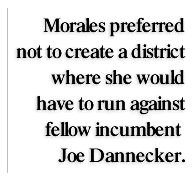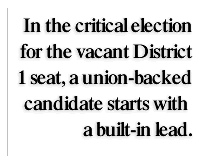The Milwaukee School Board’s Incumbent Protection Plan
Consultant Fred Kessler drew up a redistricting plan that would carve out a Hispanic school board district, but almost no one on the board seems to support the idea. That includes Jennifer Morales, herself a Hispanic, who clearly wasn’t excited about a redistricting plan that would force her to run against fellow incumbent Joe Dannecker.
 “I think we’re going to ignore the pleas of Hispanic activists and keep things as close to stability as possible,” says board member John S. Gardner. Gardner predicts there will be a 9-0 vote in favor of the status quo. “Unless I decide to be the lone hold-out.”
“I think we’re going to ignore the pleas of Hispanic activists and keep things as close to stability as possible,” says board member John S. Gardner. Gardner predicts there will be a 9-0 vote in favor of the status quo. “Unless I decide to be the lone hold-out.”
Gardner, of course, is the only at-large candidate, meaning his district is the entire city, so he is unaffected by any redistricting plan. But he speaks Spanish himself and has been a longtime advocate of redistricting to benefit minorities, going back to his days as an organizer in New York. “We’re very closely approaching the time when 20 percent of our students are of Hispanic heritage. It’s important to have someone who is accountable on the issue of language differences,” he says.
Morales, whose current district runs from the East Side to the near South Side, which includes many of Milwaukee’s Hispanic families, is Mexican-American, with Filipino and Irish forbearers as well. She speaks Spanish, and obviously owes her election in part to doing well among Hispanics, but her district is majority white.
The redistricting question was a thorny one for Morales: should she support a Hispanic district or a plan that is more likely to assure the reelection of the board’s one Hispanic representative? “I invited Latino representatives to talk about this and people gave me two goals,” Morales says, “make sure I kept my seat and get a majority Hispanic district.”
Morales suggests that protection of minority incumbents is one factor the court looks at in reviewing redistricting plans. But Kessler, a former legislator and judge who has been drawing up redistricting plans since 1962, doubts this would be a problem. “Any of the plans I’ve drawn up [for the school board] would pass constitutional muster,” he says. “I’ve never had a plan I’ve done that was overturned by the courts.”
Kessler says the protection of a minority incumbent is one factor the courts look at, but it’s possible to get a Hispanic district and get Morales reelected. As Gardner notes, “Morales is clearly a very good vote getter on the East Side.”
But Kessler says even drawing up an all south-side district to maximize Hispanic representation is problematic. “The maximum we could have created was a 42 percent Hispanic district,” he notes, “because so many aren’t U.S. citizens [and thus can’t vote].”
Because of that, Morales says, “I realized the best thing was to adopt a map that the Latino community can grow into over time.”
Kessler originally created two proposals: Plan A, which featured minor changes (mostly to increase the percentage of black voters in Peter Blewitt‘s district) and Plan B (with the Hispanic district). He’s now added Plan C at the request of incumbent Charlene Hardin, who he says was worried about losing some precincts in her district. The ironic result is that Blewitt’s district will turn into a majority white district in order to offer an African American, Charlene Hardin, more protection. Blewitt, Kessler says, has no problem running in either a majority black or white district.
Under Plan C, the number of black majority districts drops to three (as opposed to four such districts in Plans A and B), but most expect the board to approve this one. “The incumbents, whatever their politics, all ended up being conservative about their district boundaries,” Gardner grumbles.
To check out full-color versions of the redistricting maps, check this website:
www.milwaukee.k12.wi.us/governance/FullPlan.pdf
Can The Mayor Prevent a Union Takeover?
The school board is also poised to approve a special, spring election for District 1, the far-northwest-side district that is vacant due to the retirement of Donald Werra. The election is crucial, since the current board is divided evenly on many issues, with four board members leaning toward the teachers union and four leaning against.
 The primary would be held on February 19 and the general election would be on April 2.
The primary would be held on February 19 and the general election would be on April 2.
Gardner says the election could go either way. “In that district, the union starts with about 1,200 votes and the people who hate the union are about 1,000 votes,” says Gardner, an anti-union board member who has studied past elections.
Gardner expects the union to try to run two candidates, in hopes both would be elected in the primary so the union can coast after that. “I think they’re straddling Bob Harris [who opposed Gardner in 1995] and Annie Wacker [who is the president of the Milwaukee Public Schools secretaries’ union].”
Two possible independent candidates, according to Gardner, are Karen Murphy-Smith and Roxanne Starks. Gardner calls Murphy-Smith a “lefty activist” who may be too liberal for the district. Starks, a board member of a P.T.A. group, is more moderate, but that leaves her in what former school board president Bruce Thompson called “the valley of death.” She isn’t passionate enough on the school choice issue to draw money from pro-choice business leaders or anti-choice union leaders. No other groups care enough about board elections to donate money, which is why moderates have a hard time getting elected.
Kessler notes the redistricting plans he drew up will increase the percentage of black voters in the district, but he’s not sure that will make any difference. “Race has never been a determinative factor in that district,” he notes. “In the last ten years, the district had never voted race.”
That’s a cheering note for a city often labeled as racist. And it leaves the election down to the usual issue of who does the best grass roots organizing. Absent a very concerted effort by the mayor and the business community, the edge goes to the union. “They have the better machine, in terms of voter lists, money, yard signs and such,” Gardner says.
Still, Gardner contends, a union-backed candidate is likely to be less doctrinaire than in years past. “The union has realized the days of choosing dupes and lackeys is over.”
Murphy's Law
-
Is Legislature Biased Against Working Class?
 Apr 4th, 2024 by Bruce Murphy
Apr 4th, 2024 by Bruce Murphy
-
Associated Press Will Decline in Wisconsin
 Mar 27th, 2024 by Bruce Murphy
Mar 27th, 2024 by Bruce Murphy
-
City Attorney Race Is Vitally Important
 Mar 25th, 2024 by Bruce Murphy
Mar 25th, 2024 by Bruce Murphy
















